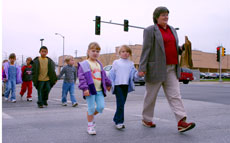Dangerous intersections, streets require attention from students

Online Poster
November 19, 2004
When walking around campus, students may need to pay more attention to dangerous intersections and crosswalks.
According to Lieutenant Skip Frost of the University Police, dangerous intersections on campus include most intersections on Green Street, specifically the intersection of Green and Neil streets. Frost also cited the intersection of Springfield and Goodwin avenues as dangerous to cars and pedestrians.
Sergeant John Brown of the University Police said many accidents also occur at intersections that are not typically considered dangerous.
“We’ve had fatal accidents or severe accidents at several locations, but it doesn’t always involve a dangerous intersection,” he said.
Brown said there have been fatal accidents at Fourth Street and University Avenue and at Fourth Street and Gregory Drive, but neither of those intersections is usually considered hazardous.
Get The Daily Illini in your inbox!
Steve Tarrant, a Champaign State Farm insurance agent, said he deals with car accident claims from various intersections on campus. He said some accidents at risky intersections do not only involve automobiles.
“With this community, I see some accidents with automobiles and pedestrians, but not too many. Those account for about 5 percent of accidents,” he said. “I also see bicycle-to-automobile accidents, which is kind of interesting when a bicycle can actually run into a car pretty easily, such as on a college campus.”
Tarrant said that when an insurance agency like State Farm classifies an intersection as dangerous, they use a point system that takes into account the number of accidents involving automobiles, pedestrians and bicycles.
He said an average intersection that is not considered dangerous receives about 400 points, and a dangerous intersection receives a few hundred more than that. The most dangerous intersection in Illinois is in Elmhurst, with a rating of 1,613 points.
Brown added that many intersections on campus remain risky areas despite the amount of work done on them.
“They’ve spent millions of dollars fixing up Sixth Street, Green and Wright Streets. They’ve used money for new lights, signs and crossing lights,” he said. “It’s unfortunate students don’t always obey the walk/don’t walk signs.”
Brown said the problem is intensified by the volume of students and possible negligence of drivers.
“Anytime there are students crossing the street, there are drivers that may not be paying attention,” he said. “There is a great flow of traffic on campus and a lot of pedestrians. Some of the pedestrians may even include intoxicated people at night.”
The Champaign-Urbana Mass Transit District (MTD) must also deal with dangerous intersections. However, Tom Costello, assistant managing director of MTD, said the buses are able to avoid some dangerous intersections on Green by limiting the number of turns on bus routes.
“A lot of it is turning movements and we don’t do many turning movements. For the most part, we’re just going east and west on there,” he said.
Unfortunately, Costello said the MTD is still involved in accidents each year.
“Typically, the MTD has something in the neighborhood of 55 to 50 accidents a year, of which we’re probably at fault maybe 10 (to) 14 times out of those,” he said. “Most of these (accidents) are just people running into us.”
Neil Reimer, sophomore in LAS, said that while he does not always follow the crossing signals, he has different ways of keeping himself safe while walking to classes and around campus.
“I always try to cross in packs,” he said. “Usually, I wait for the white walk sign and I just use common sense, like looking both ways at a corner.”
Mohammed Esmail, sophomore in business, has a car on campus. He said he is a much more cautious driver on campus streets.
“I know I have to be careful when driving my car and constantly be watchful of careless students,” he said. “I always try to maintain a safe following distance, keep the music off so I can hear anything out of the ordinary and to drive as defensively as possible while I’m on campus.”






